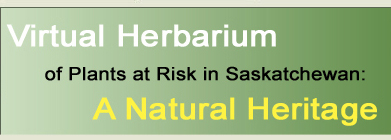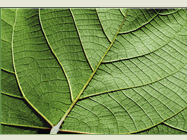|
| Elymus elymoides
ssp. elymoides (Raf.) Swezey |
|
| |
| TAXONOMY |
| |
| Family: |
Poaceae |
| Genus: |
Elymus |
| |
| Species Synonyms: |
Elymus sitanion J.A. Schultes
Sitanion
elymoides Raf.
Sitanion hystrix (Nutt.) J.G. Sm |
| Common Names: |
squirreltail
western bottlebrush grass
bottlebrush squirreltail |
| |
| DISTRIBUTION |
| |
| Canada: |
southern British Columbia – southwestern
Saskatchewan |
| Saskatchewan: |
southwestern Saskatchewan; Empress – Val
Marie |
| Ecoregion: |
Mixed Grassland, Cypress Upland |
| |
| HABITAT |
| |
| Saskatchewan: |
dry, eroded, clay banks and benches |
| Associated Species: |
longleaf wormwood, needle-and-thread grass, tufted
fleabane |
| |
| RARITY STATUS |
| |
Provincial
Status According
to Harms (2003): |
Threatened |
| Nature Conservancy
Status: |
G5 S2 |
Saskatchewan
Species at
Risk Status: |
Vulnerable |
| COSEWIC Status:
|
None |
| |
| Squirreltail is
threatened because of rarity in Saskatchewan. It is regionally restricted
to one general region of the province and is almost always locally sparse.
Possible threats have been identified for this species. |
| |
| SPECIES
DESCRIPTION |
| |
| Height: |
10 – 50 |
| Roots: |
fibrous |
| Stems: |
tufted, hollow, erect or spreading, smooth |
| Leaves: |
blades flat to rolled, 1 – 4 mm wide, ridged
above, upper surface rough hairy, lower surface hairless to short hairy;
sheaths hairless to hairy, upper often inflated; ligule membranous, 0.1
– 0.5 mm long, tip square; ear-like lobes at the base of the leaf
present |
| Inflorescence: |
spikes 2 – 15 cm long (including awns),
green or purplish; spikelets 2 per node, on alternating sides at each node;
central axis separating at maturity |
| Spikelets: |
2 – 3-flowered |
| Florets: |
glumes triangular, very narrow, 1 – 2-nerved;
glume awn 5 – 9 cm long, rough-hairy, divergent at maturity; lemma
rough-hairy to short-hairy, 5-nerved, awned from the tip; lemma awns 1 –
3, widely spreading rough-hairy; palea nearly equal to the lemma |
| Fruits: |
grain |
| |
| ELYMUS
KEY FOR SPECIES FOUND IN SASKATCHEWAN |
| |
| 1 Spikelets 2 or 3 at each node or
central axis, 1 – 6-flowered; lemmas obscurely 5-nerved |
2 |
| 1 Spikelets solitary at each node
of central axis, each spikelet with at least 2 florets; lemmas 5 –
7-nerved |
8 |
| |
|
2 Glumes, if present, bristle-like,
divided to base into 2 divergent awns; central axis of spike readily separating;
plants mostly 10 – 50 cm tall
|
E. elymoides ssp. elymoides |
| 2 Glumes bristle-like or not; central
axis of spike not readily separating; plants mostly taller than 50 cm |
3 |
| |
|
| 3 Glume margins membranous, not nerved;
lemmas hairless to rough hairy |
E. glaucus ssp. glaucus |
| 3 Glume margins thickened, hard, and
nerved; lemmas densely hairy |
4 |
| |
|
| 4 Glumes bristle-like, reduced or
absent, usually < 6 mm long (excluding awn) and 0.5 mm wide |
E. diversiglumis |
| 4 Glumes linear, usually at least
1 cm long (excluding awn) and 1 – 2 mm wide |
5 |
| |
|
| 5 Glumes shorter than lemma body;
lemma awns divergent at maturity; base of glume flattened |
6 |
| 5 Glumes equal to or longer than lemma
body; lemma awns straight at maturity; base of glume rounded or bowed |
7 |
| |
|
| 6 Leaves firm, hairless or rough hairy
above; spikes arching; palea to 1.1 cm long |
E. canadensis var. canadensis |
| 6 Leaves thin, long hairy above; spike
pendulous; palea to 1.5 cm long |
E. canadensis var. wiegandii |
| |
|
| 7 Glumes and lemmas long-awned (to
1.5 cm) |
E. virginicus var. virginicus |
| 7 Glumes and lemmas sharp-tipped to
short-awned (< 2 mm) |
E. virginicus var. submuticus |
| |
|
| 8 Rhizomes short or absent; florets
separating above the glumes; anthers 1.5 – 2 mm long |
9 |
| 8 Rhizomes long and creeping; florets
separating below the glumes; anthers 3 – 7 mm long |
10 |
| |
|
| 9 Awns equal to or longer than lemma |
E. trachycaulus ssp. subsecundus |
| 9 Awns absent or much shorter than
lemma |
E. trachycaulus ssp. trachycaulus |
| |
|
| 10 Leaves flat, 4 – 8 mm wide,
green; lemmas hairless or nearly so |
E. repens |
| 10 Leaves rolled, 1 – 3 mm wide,
bluish; lemmas usually hairy |
11 |
| |
|
| 11 Glumes 2 – 3-nerved; lemmas
long-awned |
E. albicans |
| 11 Glumes 3 – 5-nerved; lemmas
awnless |
12 |
| |
|
| 12 Spikes to 25 cm long, central axis
hairy below spikelets; glumes conspicuously 5-nerved; lemmas densely hairy |
E. lanceolatus ssp. psammophilus |
| 12 Spikes to 15 cm long, central axis
hairless below spikelets; glumes 3-nerved, only the midvein conspicuous;
lemmas hairless or hairy |
13 |
| |
|
| 13 Lemmas hairless or rough-hairy |
E. lanceolatus ssp. lanceolatus
var. riparium |
| 13 Lemmas long-hairy |
E. lanceolatus ssp. lanceolatus
var. lanceolatus |
| |
|
| *Elymus hybrids
occur naturally in Saskatchewan. E. X maltei (E. canadensis
x E. virginicus) and E. X pseudorepens (E.
trachycaulus x E. lanceolatus) are examples. |
|
|






